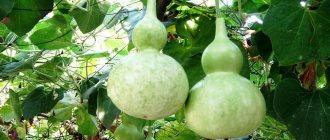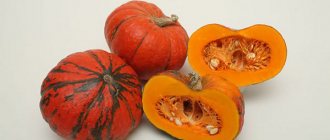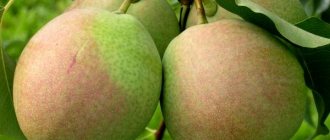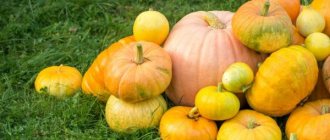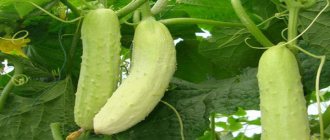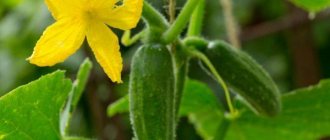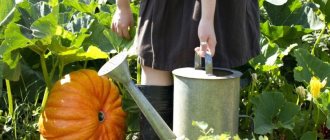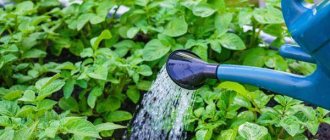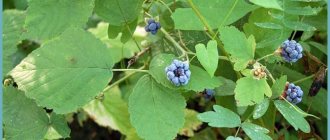Types and varieties of plants, appearance
It is here that you will see unusual fruits of one-color, two-color, spotted and striped colors. Their skin can be smooth or ribbed, ranging from white to dark red or a deep bottle color. The shape of pumpkins can be round, elongated, flattened or curly. And it is impossible to say which one is the most beautiful. Take a close look at what decorative pumpkins look like, photos and names of varieties depending on their appearance.
Often, decorative pumpkin seeds are collected in seed mixtures depending on the shape, coloring or size of the fruit. They can resemble mushrooms, stars, light bulbs, bottles, as a result of which the names of varietal mixtures of the most interesting herbaceous plants of the genus Cucurbita were formed.
- The varietal mixture Crown from Plasma Seeds is multi-colored pumpkins with a star-shaped shape, and Turkish Turban from Article is a turban-shaped form of all fruits of different colors.
- Small orange pumpkins (Orange variety) have a slightly flattened spherical shape and look very much like citrus.
- Silver pumpkins (Baby Boo variety) have an original ribbed appearance, white flesh, and are most often used in interior decor of residential premises.
- A pear-shaped mini-pumpkin (Kleine Bicolor variety) with a contrasting color - a dark green bottom and a bright orange or bright yellow neck with a clear separation of colors, is also of interest to designers.
- But Laginaria, a bottle gourd (Cobra variety), has found its place of honor among landscapers in landscape design.
- Large-fruited pumpkin (variety Cucurbita maxima), shaped like a giant mushroom, is represented by fruits of various colors and shades.
Cobra
Pumpkins of this interesting variety can become a very unusual decoration for landscape design. Seeing the “cobra’s head” peeking out from the wide green leaves can scare anyone. This type of laginaria produces such original fruits. They are dark green in color, with light stripes, long curved necks and a small head.
Pumpkins can not only be a decoration, but also serve as a medicinal product. They have a diuretic effect, strengthen blood vessels and the heart.
Distribution area
Pumpkin is a melon crop that came to our latitudes from the African continent. Some seeds of Cucurbita pepo var.ovifera came to us from Mexico, as well as from China. The plant is thermophilic and prefers to grow in sunny areas.
Among all the introduced species and those cultivated in our environment, there are both liana-like and bushy forms that bear fruit with pumpkins. Pay attention to the variety of species and how decorative pumpkin bears fruit, photos and names of varieties of this amazing plant.
Diseases and pests
The following dangers exist for decorative pumpkins:
- Powdery mildew. It is a white coating that covers the leaves and lashes. Leads to the death of ovaries and fruits. Spraying with a 1% vitriol solution will help cope with the problem.
- Root rot. A fungal disease that causes the plant to die, starting from the root. It can be prevented if all watering conditions are followed.
- Slugs. They gnaw leaves and damage fruits. You can get rid of them if you treat the ground with a mixture of ash and lime in equal proportions.
- Melon aphid. A parasite that causes leaves to rot and curl. It often occurs if the standards of care, crop rotation and proximity of crops are not followed. A way to save plants is to spray them with a weak soap solution.
Powdery mildew of pumpkin
Pumpkin root rot
Slug on a pumpkin
melon aphid
Benefit
The lush climbing greenery of the plant itself is successfully used as garden decoration. They cover gazebos, verandas and fences. In addition, the large leaves of the plant provide dense shade. Look at the photo how original the decorative arch, entwined with weaving shoots, looks. Bush varieties are planted in flower beds for the sake of gorgeous greenery and the same original multi-colored fruits that the crop produces.
At the beginning of summer, the rapidly growing green thickets are decorated with large, bright flowers. True, not all of them have a pleasant aroma, but they quickly fade. As a rule, flowers have no scent at all. And already in the middle of summer, fancy pumpkins of various shapes and colors develop on the plant.
Crown
This heat-loving plant is best planted in the brightest place. It produces amazingly beautiful fruits in the shape of stars or crowns. The variety is decorative, climbing, and can be used to decorate any wall or gazebo.
The original fruits grow in a variety of colors: yellow, green, orange and striped. After drying, they can be stored for a very long time and used for interior decoration and crafts. The vegetable is not suitable for eating.
Use of fruits
Unlike cultivated plants, ripened Pepo fruits are practically devoid of pulp, but their shell is very dense and does not allow water to pass through. This dried large-fruited pumpkin was used as a vessel for liquids by ancient peoples.
In the modern world of design, pumpkins in the form of stars, bottles, mushrooms, citrus fruits or pears have long found their use. Due to the originality of their shapes and variety of colors, they are used in the interior to decorate space - all kinds of non-trivial vases, exquisite boxes with lids, all kinds of candlesticks.
This is the most unusual eco-style decor, and you can do it yourself, even involving children in the event, especially when celebrating everyone’s favorite Halloween party on the eve of All Saints’ Day.
Harvest and storage
Harvest before the first frost - in September-October. For gastronomic purposes, vegetables are cut unripe so that they do not have time to become tough. During the ripening process, the taste improves. However, the longer the fruits lie, the harder they will become. So, by spring they become so hard that they are suitable for making dishes.
At home, Little Red Riding Hood lies for about a year. To prevent pumpkins from spoiling for a long time, they are cut with a foot no shorter than 5 cm.
Advice ! For planting next year, the seeds are stored in the fall. The ideal place for this is wet sand. Store seed in the refrigerator or on a closed balcony.
The nutritional value
In culinary terms, Cucurbita pepo is not considered edible.
The pulp of Lagenaria can be eaten, and even then with a “stretch”, since not only the skin of the fruit is quite hard, but also the flesh under the skin is not tasty enough, unlike a cultivated plant. Only in a state of milky ripeness can something still be prepared from exotic fruits. But there is no guarantee that your food will not be “bitter.” Important ! The use of ornamental fruits for livestock feed is not recommended due to their extremely dense and coarse pulp.
How to grow
The variety is planted in the spring, after frosts. Seeds can be sown directly into the ground or seedlings can be prepared first. The difference will be in the timing of flowering and ripening - pumpkin seedlings will ripen and bear fruit faster.
It is recommended to plant the crop on the sunny side, next to some kind of support. For decorative purposes, gardeners sow it near the fence. Over time, the red cap begins to weave along the fence, forming a hedge.
Features of cultivation
To get a good harvest of decorative pumpkin, you should know the features of its cultivation. Little Red Riding Hood has quite a few of them:
- Vegetable crops are not picked . Transplantation begins in June. The planting scheme is as follows: the distance between plants is 0.3 m, the depth is no more than 0.3 m. The recommended distance between rows is 0.2 m.
- The turban-like culture prefers fertile soil with neutral acidity. Grows well and bears fruit on manure fertilizers. The rate of application of cow manure is 50 kg per 10 m².
- After planting, the plant is covered with film, creating a greenhouse effect. When the air warms up to 20 degrees, the film is removed. The vegetable begins to grow actively at a temperature of 30 degrees.
- It is necessary to shape the plant. Pinching begins when the lashes reach a length of 1 m.
- Turban-like grows poorly after sunflowers, watermelons, and potatoes. It is worth refusing to be adjacent to other large-fruited varieties. Red cap is best grown in complete isolation with artificial pollination.
Growing and care
Decorative pumpkins are not considered particularly whimsical, but even minor frosts are dangerous for them. Already at 0-1° C the shoots die. Therefore, planting seedlings is the best option for growing.
The soil for the crop should be loose and light. Fertile, limed soils are excellent. Cucurbita pepo can be grown on sandy loam, sandy loam or loamy chernozems. The plants do not tolerate acidic soils, but they still grow well in slightly saline areas.
The sunnier the area, the faster the shoots grow, the flower appears, and the Pepo fruits develop. Moreover, in bright sun the color of the fruits is much brighter than that of relatives growing in partial shade. In addition to growing seedlings, they also use the sowing method, sowing seeds directly into the ground when the threat of spring night frosts has completely disappeared. When planting seeds, it should be taken into account that flowers are capable of cross-pollination. An especially decorative pumpkin in the shape of a pear is a climbing vine, and from the seeds collected for planting for the next season, fruits of a completely different shape can grow.
Watering in both the first and second cases should be fairly regular. And, in addition, in order for the vine to fully develop, it is necessary to apply fertilizer to the soil every 20-21 days. If there is a lot of thickening, it is better to thin out the lashes by cutting out the side shoots. Then the flowering will be more abundant and the fruits will develop better.
Agricultural technology
To properly grow decorative pumpkins, you need to use the appropriate recommendations.
Selecting a location
Among the requirements:
- The soil. It should be dense and well heated.
- Availability of support. The plant will weave upward along it. The wall of the house will do, you can put up a trellis.
- Predecessor cultures. Plant in soil in which cabbage, beets, and legumes previously grew. Under no circumstances should you allow crop rotation with melons.
- Neighborhood. Do not plant next to onions, peas, spinach, as they attract dangerous pests.
Seed preparation
How does this happen:
- Sorting. Remove any seeds that have spots or dark streaks. To remove empty ones, place them in a glass of water and catch any that float.
- Warming up. Place in the oven and heat for 10 hours at a temperature of up to 50 degrees.
- Hardening. Wrap in a damp cloth and put in the refrigerator for 10 hours.
- Protection. Place the seeds in a weak solution of ash or potassium permanganate for 2-3 hours.
Growing seedlings
How to disembark:
- Prepare the soil mixture. To do this, mix soil, mineral and organic fertilizers in a ratio of 2 to 1 to 1. You can take the preparation from the store.
- Prepare containers. It is best to take peat cups.
- Plant the seedlings. Pour soil into the pots and make a hole up to 5 cm. Plant 1 seed at a time. Sprinkle with soil. Water and cover with transparent film. It must be removed after germination.
What is further care?
- Choose a location. Transfer the pots of seedlings to a well-lit windowsill.
- Adjust the temperature. It should be within 15-20 degrees.
- Water. Do this with room temperature water as the soil dries out.
- Feed it. Do this 2 times during seedling growth. Use a mixture of 10 liters of water, 20 g of potassium and the same amount of superphosphate.
- Harden it up. 2 weeks before transplanting into the ground, start taking pots of plants outside every day.
The seedling method is more suitable for residents of the northern regions.
Planting in open ground and greenhouse
Usually occurs on the 30th day after planting seeds for seedlings. In time this is the end of May - beginning of June.
How to do it:
- Prepare the area. To do this, dig up the soil. Make holes about 10 cm deep. Add fertilizer to each hole - 3 tbsp per 1 liter of warm water. l. ash and 2 tbsp. l. superphosphate.
- Consider the diagram. The distance between plants is at least 60 cm.
- Replant. Transfer the seedling into the hole along with the peat pot and sprinkle with soil.
- Mulch. Use peat or sawdust. Then add a thin layer of soil.
If you are going to grow pumpkins in a greenhouse, make sure there is good ventilation before planting and during the flowering period.
Planting by seeds
This method is suitable for residents of the southern regions.
What do we have to do:
- wait until the soil warms up to 15-20 degrees;
- apply fertilizer;
- make holes at a distance of 40-50 cm;
- plant 2 seeds in each so that in the future you can pinch off a weaker sprout;
- sprinkle with earth;
- water it.
Care
For better growth, you need to take proper care of your plants.
Watering
Adviсe:
- Frequency. Immediately after planting, you will need to repeat the procedure up to 4 times a week. As you grow, you can reduce it to 4 times a month.
- Water. It's better to take it at room temperature.
- Way. Apply at the root.
Feeding
Conducted every 15-20 days. Organic or mineral fertilizers are used.
Loosening and weeding
Produced as weeds emerge. When the lashes form, this needs to be done more carefully so as not to damage the plant. Usually weeding is carried out before watering, and loosening - after.
Pollination
As a rule, insects cope with this, but if for some reason they rarely fly into the area or the plants are in a greenhouse, you will have to carry out the procedure yourself.
It is better to do this early in the morning:
- take a brush with soft bristles;
- “dip” in the pollen of a male flower;
- transfer to the female flower.
How are finished pumpkins processed?
When using dried pumpkins to decorate the interior of your home, you will have to pre-treat the vegetable. First, all fruits are polished with sandpaper to get rid of the husks on the surface. Then a design is cut out on the walls and painted. Some people rub the surface of the fruit with wax to make it more durable.
When making dishes, pumpkins are drilled with a drill with various drill bits to make holes of the required diameters in them. Before you start drilling, the vegetable is opened and all seeds and pulp are removed from it.
Portioned pumpkins
This year I discovered small pumpkins! I share my impressions!
These are super convenient fruits! Firstly, there are a lot of them on the plant, literally, garlands of fruits! Secondly, they are very easy to use! Thirdly - beautiful!
I had a bag given by a neighbor as unnecessary (she bought it and didn’t look at the size of the fruits on the bag of seeds), and since my chickens happily eat all the pumpkin crops, she decided that I needed such a pumpkin more))
I, in turn, planted pumpkins at the far end of the plot and forgot about them! Accordingly, the care was purely “from Mother Nature.” My surprise began with the fact that my little daughter, who explores every corner of the plot, brought me a beautiful fruit...
I didn’t remember exactly what I was buying such a miracle, so I began to wonder where the child got the wonder? And then it dawned on me where this miracle came from)) My son and I went to see a plantation of small pumpkins! Of course, we didn’t immediately see the treasures in the thickets of grass and leaves, but when we collected about 10 different ones, we immediately decided what we would do with them! Stuff! Immediately!
And during the season, we collected fruits, mainly my daughter brought them as balls, and prepared various dishes.
In mid-August, I decided to conduct an experiment on one pumpkin plant of the Candy variety! Don’t ration the harvest, but let everything take its course... in the end I also got little sweet balls of Candy! Yes, it’s stupid, of course, to use a plant like that, but I have a solid pumpkin harvest,
The bulk goes to feed the chickens, that's why I had fun))
I decided for myself that it’s better to eat portions and plant them in food! They can be consumed at technical ripeness and stored after full ripening. Everything is the same as the large-fruited one! Of course, with my love for gigantomania, I won’t be able to switch completely to portioned pumpkins, but perhaps someone in a small area could use this variety? Or maybe those who don’t really like pumpkins precisely because of their large size will also like this little pumpkin?
These are the beauties in the garden
Having once discovered a stuffed pumpkin, you understand that you still need to have time to collect such a fruit for baking so that it is not overgrown, but the pulp is already sweet. And portioned pumpkins are a great help in this matter!
I had three varieties in the set of seeds: Melon, Sweetie and Mandarin.
I can recommend everything to you!
And now, since I’m writing about pumpkins, another discovery of the season for me was the Marble pumpkin.
Truly sweet and you can eat it just by taking a bite, no sugar needed! She will pull 3-4 kg. The flesh is bright orange!
Maybe this little pumpkin will help you out too? Or are you not ready to give up large-fruited pumpkin in favor of portioned pumpkin?
When is the harvest
Decorative fruits should be removed before frost sets in (freezing will make the pumpkins unsuitable for long-term storage). Cleaning is carried out in warm, dry weather. A characteristic sign that it is time to pick the fruit is when the stalk dries out and darkens to a brown tint.
Attention! When removing, they try not to damage the skin; the stalk is not removed, but rather a 5-6 cm tail is left.
Ripe pumpkins are dried and used for fakes, interior decoration, winter and autumn arrangements. Small pumpkins are dried entirely without cutting out the core. Large fruits (more than 10 cm in diameter) are carefully cut from the top in the shape of a cap and the pulp and seeds are removed.
A properly prepared decorative pumpkin is used for carving. The surface can be painted with paints and a varnish base can be applied.
Reference! To maintain brightness, fruits are stored in dark rooms, at 16-18 degrees and humidity not higher than 65%.
In order to unusually and beautifully decorate a recreation area or the territory of a personal plot, it is not at all necessary to plant exotic plants or arrange garden figurines. You can actively grow decorative pumpkins and create luxurious compositions with canopies, carts, and columns. Small fruits are used for inspiring burning, artistic painting, and cutting out wonderful decor - lanterns, vases, dishes.
Currently reading:
- Three main methods for growing pumpkins in the garden
- Planting to decorate the site with three types of coniferous trees
- Choosing cucumbers for open ground according to your preferences
- We improve and restore compost with Em-preparation
Share the news on social networks
About the author: Victoria Semyonovna Nakhodkina
Leading researcher at the laboratory of vegetable and berry crops, Yakut Scientific Research Institute of Agriculture, Siberian Branch of the Russian Academy of Agricultural Sciences, Republic of Sakha (Yakutia).
Pumpkin Little Red Riding Hood: advantages and disadvantages
Decorative pumpkin Little Red Riding Hood: photo of the variety
Experienced summer residents and gardeners say that in addition to the unusual appearance, this type of pumpkin has the following advantages:
- ease of cultivation and care.
- high level of resistance to cold.
- high level of resistance to various diseases and parasites.
- high level of drought resistance.
- a large amount of harvest.
- ability for accelerated growth.
- The variety belongs to the group with early ripening.
- long shelf life of pumpkins that have reached full ripeness.
The advantages of the Little Red Riding Hood pumpkin include the possibility of vertical cultivation of this vegetable crop. The lashes easily catch on a support at a height of up to two hundred and fifty centimeters, forming voluminous thickets. Decorative varieties grow in suburban and summer cottage areas to decorate paths, gazebos and beds.
Among the disadvantages, one cannot fail to mention the bitter taste of fruits that have reached full ripeness. Other disadvantages include watery pulp and very hard peel. If you harvest a crop that has not reached full maturity, then there will be no bitterness in the taste.
